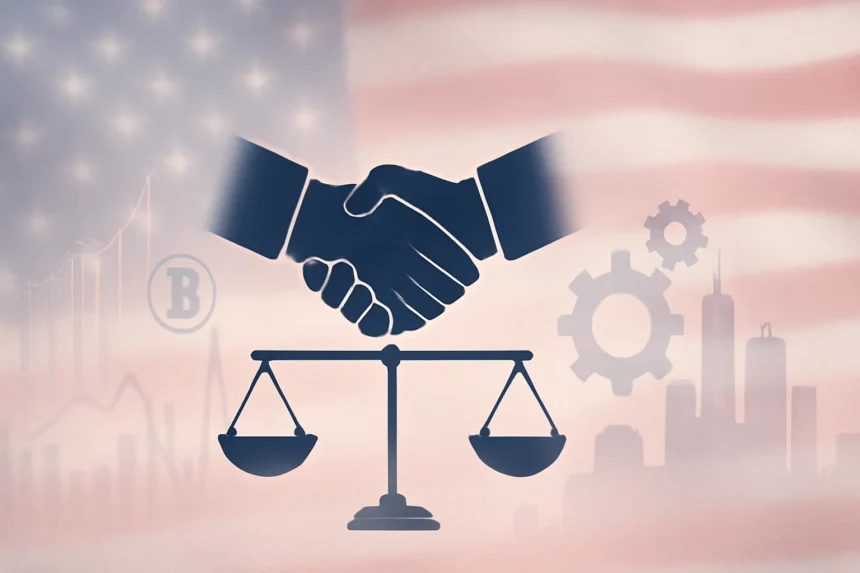Have you ever wondered what makes the world’s largest economy tick? From the price of your morning coffee to the rise of trillion-dollar tech companies, every economic decision in the United States is shaped by a foundational, and often misunderstood, system.
As a business analyst and market commentator, I often find people have a single-word answer for this question: capitalism. But the reality is far more nuanced. While the U.S. economic system is indeed rooted in capitalism, it’s not a pure form. The most accurate term is a mixed economy a blend of free-market principles and government intervention. This unique combination is the key to understanding both the remarkable innovation and the significant social challenges we face today.
In this post, we’ll break down the core components of America’s economic engine, exploring what this mixed system means for you, whether you’re a CEO, an investor, or a regular consumer.
The Foundation of the U.S. Economy
At its heart, the U.S. economic system is a capitalist one. This means the economy is driven by private ownership and the pursuit of profit. The main decisions about what to produce, how to create it, and for whom are made by individuals and businesses in a decentralized, market-based environment.
The key pillars of this system, as they operate in the United States, are:
- Private Property: Individuals and businesses have the right to own and control property, from a small business to a multi-billion-dollar corporation. This right is a powerful incentive for investment and innovation, as it allows people to benefit directly from their work and assets.
- Free Markets and Competition: In an ideal capitalist system, prices are determined by supply and demand, with minimal government interference. Businesses compete to offer the best products and services at the lowest prices, which theoretically benefits consumers and drives efficiency.
- The Profit Motive: The desire to make a profit is the main engine of the economy. This incentive encourages companies to be more productive, innovative, and responsive to consumer needs. It’s what drives new industries, from electric vehicles to AI, and pushes older ones to adapt or fail.
This free-market foundation is the source of America’s economic dynamism and entrepreneurial spirit. It’s why the U.S. has produced some of the world’s most innovative and influential companies.
The Government’s Role
If the U.S. were a purely capitalist economy, there would be no government intervention at all. In reality, the government plays a significant role, which is where the mixed label comes in. Government involvement serves to correct market failures, provide public goods, and create a social safety net.
The government’s economic functions include:
- Regulation: Agencies like the Federal Reserve, the Environmental Protection Agency (EPA), and the Food and Drug Administration (FDA) regulate industries to ensure fair competition, protect consumers, and manage the broader economy. For example, the Federal Reserve adjusts interest rates to control inflation and unemployment.
- Provision of Public Goods: The private sector often can’t or won’t provide essential services that benefit everyone. The government steps in to provide public goods like roads, public education, national defense, and law enforcement.
- Redistribution of Wealth: Through programs like Social Security, Medicare, and unemployment benefits, the government uses taxation to provide a safety net for citizens. This system is designed to reduce income inequality and protect vulnerable populations from extreme hardship.
This government involvement is not a modern invention; it has evolved over decades. For example, in the fiscal year 2024, federal spending was approximately 23% of the total Gross Domestic Product (GDP) of the United States. This significant portion of economic activity shows just how intertwined the public and private sectors are.
The U.S. Economic System vs. Other Global Models
To truly appreciate the U.S. model, it helps to compare it to others.
- Pure Capitalism: A theoretical system with no government intervention. No modern country operates this way.
- Pure Command Economy: Also known as a planned economy, this system is the opposite of capitalism. The government owns all the means of production and makes all economic decisions. Countries like North Korea are close examples.
- The U.S. Mixed Economy: A blend that leverages the power of private markets for efficiency and innovation while using government oversight to address social needs and provide stability.
The U.S. is not alone; most developed nations have some form of a mixed economy, though the balance of power between the market and the state varies widely. Countries like Sweden and Germany, for example, have more expansive social welfare programs and higher taxes, making their mixed economies lean more towards socialism than the U.S. does.
Conclusion: What America’s Mixed Economy Means for You
America’s economic system is a dynamic and ever-evolving blend of competition and cooperation. For business leaders, it’s a landscape of immense opportunity driven by private enterprise, but also one of responsibility and regulatory compliance. For everyday citizens, it offers the freedom to choose what to buy and where to work, alongside the security of a social safety net and public services.
Understanding that the economic system in the United States is not a simple concept but a complex, mixed system is crucial for anyone who wants to make wise decisions whether it’s starting a business, investing in the market, or simply trying to understand the news.



